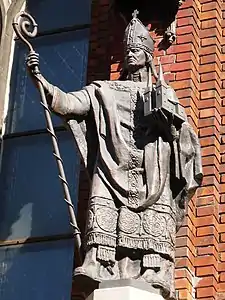Albert of Riga
Albert of Riga or Albert of Livonia or Albrecht[lower-alpha 1]; c.1165 – 17 January 1229) was the third Catholic Bishop of Riga in Livonia. In 1201, he allegedly founded the city of Riga, the modern capital of Latvia. The building of the Riga Cathedral started during his tenure there in 1221.
Albert of Riga | |
|---|---|
| Albrecht (German), Alberts fon Buksthēvdens (Latvian) | |
 Albert of Riga, copy of a sculpture by Karl Hans Bernewitz on the facade of Riga Cathedral | |
| Born | c. 1165 Bexhövede, Lower Saxony, Germany |
| Died | 17 January 1229 |
| Nationality | German |
| Other names | Albert of Bexhövede, Albert of Buxhoeveden |
| Occupation | Bishop of Riga |
| Known for | Founding the city of Riga, Livonian Crusade |
| Title | Prince-Bishop of Livonia |
Albert headed the armed forces that forcibly converted the "pagan" indigenous population of the eastern Baltic region to Christianity as a result of the Northern Crusades.
Early life
Albert was born in Bexhövede, a part of Loxstedt, Lower Saxony, Germany. He and his brother Hermann were members of the powerful Buxhoeveden family from Bexhövede. Because of this he has also been known as Albert of Buxhoeveden (or Bexhövede, Buxhövden, Buxhöwde, Buxthoeven, Appeldern).
Albert was a canon in Bremen when his uncle Hartwig, Archbishop of Bremen and Hamburg, named him Bishop of Livonia, provided that he could conquer and hold it, and convince the pagan inhabitants to become Christians. The patent was granted on 28 March 1199, and in the beginning of spring 1200 he embarked for Livonia with a fleet of 23 vessels and more than 1,500 armed crusaders. He had the support of the Hohenstaufen German king, Philip of Swabia, as well as an implicit blessing of Pope Innocent III.
In 1200, Bishop Albert led a crusade in Livonia, providing the starting point to create an ecclesiastical State.[1] Albert arrived in his diocese in Ikšķile (Uexküll) with a sizeable army. He was able to send reinforcements without asking permission from the Pope. These rights led him to create an annual summer expedition from Lübeck to Livonia called the "perpetual crusade".[2]
Foundation of Riga
When Albert realized that the diocese of Uexküll was located far away from the Daugava river to be effective, he founded a castle nearer the sea, where a small stream joined the Daugava creating a natural harbor. This castle would be the start of the foundation of Riga.[2]
Together with merchants from the Baltic Sea island of Gotland, Albert founded Riga in 1201,[3] where a small community of Hanseatic traders from Lübeck held a tentative trading encampment.[4] In 1204, he received a papal bull to sign up crusaders.[1]
He successfully converted many Livs under their leader Caupo, offering them protection against neighboring Lithuanian and Estonian tribes; Albert also subjugated Latvian principalities of Koknese, Jersika and Tālava later on. The conquest of Livonia in full occupied almost three decades of his life.
Albert created a military order, the Livonian Brothers of the Sword,[1] and began to build his cathedral in 1215.[5] King Philip made him a Prince of the Holy Roman Empire, with Livonia for a fief, and thus Albert became a "Prince-Bishop". In 1225, King Henry (VII) of Germany confirmed the title of Prince for Albert and his brother, Hermann. Albert declared his diocese independent of Bremen, and later Riga was raised to an archbishopric.
A first-hand account of Albert is in the contemporary Livonian Chronicle of Henry by Henry of Latvia.[2]
Albert died in Riga in 1229. As a Catholic Bishop, he left no descendants. He was venerated as a Catholic saint until the Protestant Reformation. The present-day von Buxhoeveden are descendants of his cousin Johannes von Buxhoeveden. Albert's brother Theodoricus married a niece of the prince of Novgorod Mstislav Mstislavich[6] and is the progenitor of the family de Raupena (de Ropa, known today as "von der Ropp") that founded manors in Livonia and Courland.
Albert Street in Riga is named after Bishop Albert.
References
- Tyerman, Christopher (2006). God's War: A New History of the Crusades. Cambridge, Massachusetts: The Belknap Press of Harvard University Press. pp. 689–691. ISBN 0674023870.
- Turnbull, Stephen R. (2004). Crusader castles of the Teutonic Knights. 2, The stone castles of Latvia and Estonia 1185-1560. Dennis, Peter, 1950-. Oxford: Osprey. ISBN 1-84176-712-3. OCLC 56426711.
- "CATHOLIC ENCYCLOPEDIA: Albert (Albrecht), Bishop of Riga". newadvent.org. Retrieved 6 September 2020.
- Dollinger, Philippe. (1999). The German Hansa. Routledge. ISBN 0-415-19073-8. OCLC 906842818.
- Woodgate, Mik (29 December 2017). "History of the Crusades heads north with the first Northern Crusade silver coin". AgAuNEWS. Retrieved 6 September 2020.
- Хрусталёв, Денис Григорьевич (2017). Северные крестоносцы. Русь в борьбе за сферы влияния в восточной Прибалтике XII-XIII вв (in Russian). Евразия. pp. 68–1382. ISBN 978-5-91852-183-0.
External links
- Albert von Buxhoeveden (in German)
- James A. Brundage, The Chronicle of Henry of Livonia Archived 17 June 2004 at the Wayback Machine: edited and translated, 2003
- Catholic Encyclopedia article